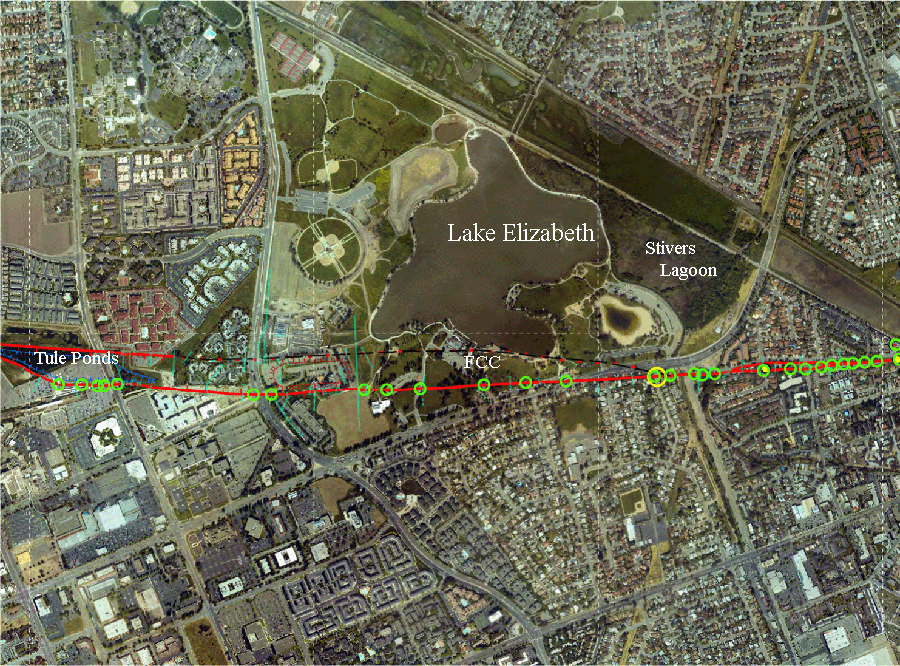|

|
The Hayward
Fault is an offset of the San Andreas Fault system that
dominates the landforms of eastern San Francisco Bay.
The relative motion between the North American Plate
(southeast) and the Pacific Plate
(northwest) create stress that releases energy as
earthquakes. This slip slide motion is called a transform fault.
The Hayward Fault is within the San Andreas Fault
Boundary Zone between the North American Plate and the Pacific
Plate. The Hayward
fault is one of only a few dozen faults in the world that “creeps,” or
slowly moves.
Evidence of creep can be found from Pt. Pinole in the north to
south Fremont.
On the surface
the Hayward Fault is a right lateral strike-slip fault. A
strike-slip fault is a vertical or near vertical break on the
Earth’s surface where the ground moves horizontal in opposite
directions. If you stand on the fault and the motion moves your
right, it is called a right lateral. When an area of a fault moves
suddenly it is called an “earthquake”.
The Hayward Fault
trends along the east side of San Francisco Bay. Traces of the
Hayward Fault has been confirmed to be under San Pablo Bay and
research indicates that the Rogers Creek Fault and the Hayward may
be one continuous fault. As you go south it runs from just
west of Pinole Point on the south shore of San Pablo Bay and through
Berkeley (just under the western rim of the University of
California’s football stadium). The Berkeley Hills were formed by an
upward movement along the fault. In Oakland the Hayward Fault
follows Highway 580 and includes Lake Temescal. North of Fremont’s
Niles District, the fault runs along the base of the hills that rise
abruptly from the valley floor. In Fremont the fault runs within a
wide fault zone.
Around
Tule Ponds at Tyson Lagoon the fault splits into two traces and
continues in a downwarped area and turns back into one trace south
of Stivers Lagoon. When
a fault takes a “side step” it creates pull-apart
depressions and compression ridges which can be seen in this
area. Southward, the
fault lies between the lowest, most westerly ridge of the Diablo
Range and the main mountain ridge to the east.
Coyote reservoir, Leroy Anderson reservoir, and San Felipe
Lake all lie on the fault. It breaks from the San Andreas Fault near
Hollister.
The Hayward Fault is slowly ripping
the City of Fremont.
The faulting is what has given this city its dramatic hills,
and valleys making it a scenic and unique place.
Leland Stanford had his summer home in the Warm Springs area
because of its hot springs caused by faulting.
His guests would bath in the springs in front of his summer
mansion. John Rock
expanded the California Nursery Company in Niles, in a unique
microclimate where the Hayward Fault changes from mountain to
valley. Lake Elizabeth,
a human made structure prevents flooding downstream, and expands the
large sag pond caused by
the down warping of the Hayward
Fault in this area.
Even the famous fossils beds in the Irvington District were
exposed by the constant uplifting of one side that reveals a large
river that would trap bones of large Ice Age mammals like mammoths
and sabertooth cats.
In the picture below the trace of the Hayward Fault through
Central Park is delineated in red.
The green circles represent evidence of creep or slow
movement in a slip slide motion (transform).
The “Faulted Floor Exhibit” is just above Mission View Drive
at Paseo Padre.
This map is based on scientific data obtained by Dr.
James Lienkaemper from the U.S. Geological Survey, Menlo
Park.

If you have any questions, comments, or suggestions please contact:
msn@msnucleus.org or call
(510)790-6284
[Home]
|

.jpg) Showing
Movement along the Hayward Fault
Showing
Movement along the Hayward Fault